Apostołowie Bożego miłosierdzia (ang) / Apostles of Divine Mercy
| liczba stron: | 168 |
| format: | 205x250 mm |
| papier: | kredyowy, matowy 150 g |
| oprawa: | twarda |
| data wydania: | 28-02-2016 |
| ISBN: | 978-83-7553-203-6 |
 dodaj do przechowalni
dodaj do przechowalni
WORLD YOUTH DAYS SPECIAL EDITION
The events of the lives of St Sister Faustina and St John Paul II portrayed in this book help in gaining a better understanding of the divine plan both for the two great Apostles of Divine Mercy and for spreading the message of the merciful love of God to the whole world. The Lord first chose a simple, poorly educated, yet extremely pious girl with an exceptional memory as His trustee. He inscribed upon the "blank slate" (tabula rasa) of her soul the truths of Divine Mercy, and she recorded them diligently in the Diary. Thanks to her absolute adamancy, and with the assistance of Blessed Father Michał Sopoćko, the first image of Merciful Christ was painted, and the faithful began praying to the Chaplet of Divine Mercy.
Yet Faustina needed a different follower, somebody with a personality worlds apart from hers: an exquisite theologian and great pope, who would finish the work she began. Under the power of his office and ministry he corroborated the truthfulness of the message, beatified and canonised the Secretary of Divine Mercy, proclaimed the Feast of Divine Mercy, performed the Act of entrusting the world to Divine Mercy, and consecrated the Basilica in Łagiewniki so that it could become the world centre of Divine Mercy. The work of St John Paul II is today continued by his followers, popes Benedict XVI and Francis, who announced AD 2016 the Year of Mercy. Falling back on the talents of the superb expert in the theology of Divine Mercy Father Professor Jan Machniak, the consummate journalist Jolanta Sosnowska, and the master photographer Adam Bujak, this book tells their fascinating story.
ANGIELSKA WERSJA JĘZYKOWA
TABLE OF CONTENTS
I. Card. Stanisław Dziwisz - Introduction by the Metropolitan Bishop of Cracow
II. Jolanta Sosnowska - Helena who became Saint Sister Faustina and Karol who became Saint John Paul II
III. Cracow, the Capital of Divine Mercy
IV. Father Professor Jan Machniak - Mercy brings people together and opens them to each other
V. The White Seas of Kraków, Home to the Saint
VI. The International Academy of Divine Mercy in Kraków
In 1939, one of the copies of Kazimirowski’s painting was hung in the chapel of the house of the Congregation of Sisters of Our Lady of Mercy in Płock, where Merciful Jesus presented Himself for the first time to Sister Faustina. A copy made by Łucja Bałzukiewiczówna, presented to the nuns by Father Michał Sopoćko in 1940, made its way to the chapel of the Vilnius motherhouse. The first reproductions of this copy were made in Kraków, at the printing press of Józef Cebulski, in 1937.
The Apostle of Mercy was not to satisfied with them. This is what she wrote to Father Sopoćko: “these pictures are not as pretty (…). They are bought by those who are attracted by the grace of God, and God acts here Himself. Our congregation has purchased enough of these. Mother Irena distributes these little pictures and booklets. We even said that we would be giving them away at the door.” The image of Merciful Jesus for the house of the Congregation at ul. Żytnia in Warsaw was painted by Lviv artist Stanisław Batowski in 1942. A year before leaving this world, on 1 October 1937, Sister Faustina heard the following words of the Lord: “Daughter, I need sacrifice lovingly accomplished, because that alone has meaning for Me. Enormous indeed are the debts of the world which are due to Me; pure souls can pay them by their sacrifice, exercising mercy in spirit. I understand Your words, Lord, and the magnitude of the mercy that ought to shine in my soul. Jesus: I know, My daughter, that you understand it and that you do everything within your power. But write this for the many souls who are often worried because they do not have the material means with which to carry out an act of mercy. Yet spiritual mercy, which requires neither permission nor storehouses, is much more meritorious and is within the grasp of every soul. If a soul does not exercise mercy somehow or other, it will not obtain My Mercy on the day of judgment. Oh, if only souls knew how to gather eternal treasure for themselves, they would not be judged, for they would forestall My judgment with mercy.” (D. 1316-1317).
In the same month, she received a message concerning the Hour of Mercy: “At three o’clock, implore My mercy, especially for sinners; and, if only for a brief moment, immerse yourself in My Passion, particular-ly in My abandonment at the moment of agony. This is the hour of great mercy for the whole world. I will allow you to enter into My mortal sorrow. In this hour, I will refuse nothing to the soul that makes a request of me in virtue of My Passion…” (D. 1320). Another time, Jesus explained this to Sister Faustina, more extensively: “as often as you hear the clock strike the third hour, immerse yourself completely in My mercy, adoring and glorifying it; invoke its omnipotence for the whole world, and particularly for poor sinners; for at that moment mercy was opened wide for every soul. Asking in this hour you can obtain everything for yourself and for others; it was the hour of grace for the whole world – mercy triumphed over justice. My daughter, try your best to pray the Stations of the Cross in this hour, provided that your duties permit it; and if you are not able to make the Stations of the Cross, then at least step into the chapel for a moment and adore, in the Blessed Sacrament, My Heart, which is full of mercy; and should you be unable to step into the chapel, immerse yourself in prayer where you happen to be, if only for a very brief instant. I claim veneration for My mercy from every creature, but above all from you, since it is to you that I have given the most profound understand-ing of this mystery” (D. 1572). The illness of the Apostle of Mercy progressed. She was twice sent for treatment to the Municipal Sanitary Complex in the district of Prądnik in Kraków for the first time from 9 December 1936 to 27 March 1937, and then again from 21st April to 17 September 1938. After the Second World War, the facility was transformed into a hospital, which in 1990 took the name of John Paul II.
Although gravely ill and very frail, Faustina did not tend much to herself. She attended to other patients, bringing them consolation, and as far as her strength allowed, she participated in the holy mass. She made no fuss or complained. Asked by Sister Faustina, Jesus disclosed to her the date of her death. The nun shared the secret only with Father Michał Sopoćko, who visited her at the hospital in Prądnik: “on 26th September she foretold her death to me, saying that she would die in 10 days, and she did die on 5 October”. Her spiritual leader experienced an extraordinary moment, shortly before the sister left for the home of the Father: “once I saw Sister Faustina in ecstasy. It was on 2 September 1938, when I visited her at the hospital in Prądnik, after I had already said my farewells to leave for Vilnius. Having taken a few steps away, I recalled that I had brought her a few dozen copies of the prayers on Divine Mercy she had put into words (the novena, the litany, the chaplet) published in Kraków. I immediately turned back to present them to her. When I opened the door to the isolation cell she was in, and saw her immersed in prayer, seated but almost hovering over the bed. Her gaze was fixed on some invisible object, the pupils slightly dilated. As yet she had paid no attention to my entrance. I did not want to interrupt her, and intended to withdraw, yet she soon came round, noticed me, and apologised that she heard neither my knocking nor entry. I presented her with the prayers and bid goodbye, to which she answered, “see you in Heaven!’ When I visited her for the last time in Łagiewniki on 26 September, she didn’t want to talk to me, or perhaps she couldn’t, saying: ‘I’m busy communing with the Heavenly Father’. Indeed, she made an impression of being a supra-terrestrial creature. At the time I had not a slightest doubt that what you can read in her diary about Holy Communion administered by an Angel in hospital corresponds to reality.”
Sister Faustina foretold to Father Sopoćko the horrible fate Poland was to experience: “having sighed, she covered her face from the horror of the picture she must have seen at the time”, as well as the future of her congregation, and also – in fair detail – the difficulties and persecutions that her spiritual leader was to encounter “because of spreading the veneration of Divine Mercy and attempting to proclaim a feast of that name on the Low Sunday (it was easier to endure all that in conviction that this is what in this matter God willed from the beginning)” Father Sopoćko wrote in an entry from 1948. The last letter to Mother General Michaela Moraczewska, which Faustina sent in late April 1938, is full of expressions of gratitude, humbleness, and humility, and also apologies for any wrongdoing that she committed in her monastic life. Sister Faustina signed it “the greatest misery and nothingness”. “She was dying reconciled with the will of God”, Sister Kajetana recalled. “She was very peaceful during the last prayers, and didn’t want anaesthetic injections.” Having lived to the age of Christ, for 33 years, she went away to God, as Jesus announced to her on 5 October 1938. Six hours earlier, she had made her confession to Father Józef Andrasz. She had a smile on her lips, and her fading eyes were overjoyed to see the Lord: a meeting she was eagerly waiting for. At 10:45 she closed her eyes forever.
Although she called herself nothingness, the fruits of her seemingly inconspicuous life were to bring about a vast harvest all over the world many years later. Even in the first notebook of her Diary (and there were six of them altogether) Sr Faustyna noted: “I feel certain that my mission will not come to an end upon my death, but will begin. O doubting souls, I will draw aside for you the veils of heaven to convince you of God’s goodness, so that you will no longer continue to wound the sweetest Heart of Jesus with your distrust. God is Love and Mercy” (D. 281). As Sister Kajetana recorded, the funeral of Sister Faustina, which took place on 7 October, the third day following her death, attracted “very many sisters, Jesuit fathers, and a few of the laity”. The holy mass at the main altar was celebrated by Father Władysław Wojtoń, and by the Altar of the Heart of Jesus, by Father Tadeusz Chabrowski. It happened to be the first Friday of the month, and at the festival of Our Lady of the Rosary. Following the will of Sister Faustina, her parents did not participate in the ceremony, as she didn’t want them to spend money to travel from Głogowiec. Neither was any church hierarch present, nor Father Professor Michał Sopoćko, who wrote dryly in his memories, “For the lack of time, I couldn’t come to the funeral”.
Soon after the death of the Apostle of Mercy, miracles began to happen, and continue to this day. One of the first must have been the conversion of the irreligious Pan Janek, who had worked many years at the Łagiewniki grange. Seeing Sister Faustina in the coffin, he only said “oh, what an impression that person made on me”, which was a sign of vast transformation that took place in the man through her intercession. The Łagiewniki nuns who received objects that belonged to Faustina: one – a warm cape, another – the habit and the ring (a common practice in monastic orders, yet one can wonder why nobody thought to keep these objects as relics of a mystic) often addressed God through her intercession and experienced graces. With time, the veneration began to intensify, with more and more people arriving at the grave of Sister Faustina already at the beginning of the Second World War, the chapel of the Łagiewniki Convent became open to general congregants. It was also visited by Archbishop Adam Sapieha.
The painter of the first image of Merciful Jesus, Eugeniusz Kazimirowski, died a year after Faustina. His painting, whose frame bore the inscription "Jezu, ufam Tobie!" (Jesus, I trust in You!), at the time not yet an integral part of the image, was hung by the main altar in the Church of St Michael in Vilnius, where Father Sopoćko was the rector, by the concession of the Metropolitan Bishop of Vilnius, Archbishop Romuald Jałbrzykowski, who in 1941 established a special commission of experts which announced that the painting has significant religious and artistic merits. Yet, in 1951, the metropolitan issued an unfa-vourable opinion about the devotion to Divine Mercy. For 11 years, the image received its due veneration in the Church of St Michael in Vilnius, yet its veneration would have certainly been practised more broadly had it stayed in the Gate of Dawn. Father Sopoćko found no support, be it with the Metropolitan Bishop of Vilnius or other Polish hierarchs, notably the Primate of Poland, Cardinal August Hlond, who told him that the Church knows no custom to set up holidays in praise of individual qualities of God.
Desperate, he therefore went to Rome in April 1939, but was granted no audience with Pope Pius XII, who had held the Throne of Saint Peter from 2 March. He was not even allowed into the secretariat of the state or the Sacred Congregation of Rites, so as to present the burning case that did not let him sleep at night. To be able to make the orders of Jesus come true, aside from the incessant efforts Father Professor Michał Sopoćko, an educated theologian highly involved in the mission of spreading Divine Mercy, another eminent theologian was needed. One who would additionally first receive the power of a bishop, and later of the Vicar of Jesus Christ, and, having seen to all the prescribed procedures, would introduce the veneration, the devotion, and the Feast of Divine Mercy to the entire Church. Yet, when Sister Faustina Kowalska was dying, that someone had just turned nineteen.
When Sister Faustina was dying, Karol Wojtyła had just passed his secondary school final exams with distinction. Together with his father, he had also already managed to move from Wadowice to Kraków, where they made their home in the district of Dębniki at ul. Tyniecka 10, in two small, quite dark rooms with a kitchen, on the lower ground floor of the house that belonged to his maternal relatives. The future pope was embarking on studying Polish Philology in the Faculty of Philosophy of the Jagiellonian University. The Wojtyła’s had moved to the new local parish of St Stanislaus Kostka with its recently built church. Karol Wojtyła had a special devotion to an image of Our Lady Help of Christians hanging in the church, before which, as he was later to mention, he would learn his vocation thanks to prayers. Another church he favoured was Wawel Cathedral, whose towers are well visible on the other side of the Vistula from Dębniki, also because it is the last resting place of Polish monarchs and heroes. He went there on the first Friday of every month to confess to Father Kazimierz Figlewicz, his teacher of religion in Wadowice, and also to participate in important services. His university colleague, and later an eminent Slavicist and comparatist, Professor Maria Bobrownicka met him in the Cathedral on 6 April 1939: “He attended the Maundy Thursday celebration of washing the feet by Archbishop Sapieha in Wawel. Then he long remained immersed in thoughts by the tomb of King Jagiełło. Then he long prayed before the Holy Sacrament in the Báthory Chapel.” Little could suggest at the time that Karol Wojtyła would choose the spiritual vocation, although from the earliest years he stood out with his piety, and was a long-term president of the Marian Sodality of lower secondary school students, and experienced all religious services deeply. Yet he was also an aficionado of literature, wrote poems himself, and avidly performed in the theatre. Furthermore, Karol dreamt of Polish philology studies and acting. He was in love with Polish classics: Słowacki, Mickiewicz, Wyspiański…



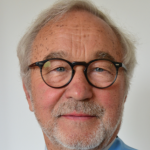




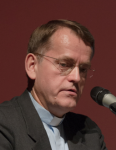



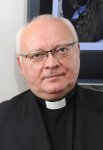
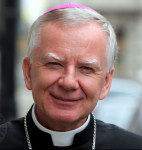
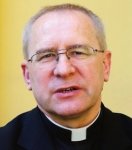
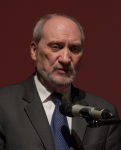

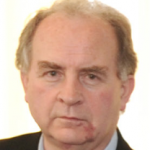

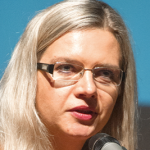



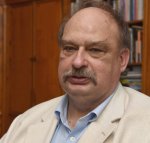


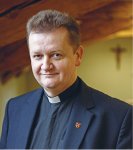








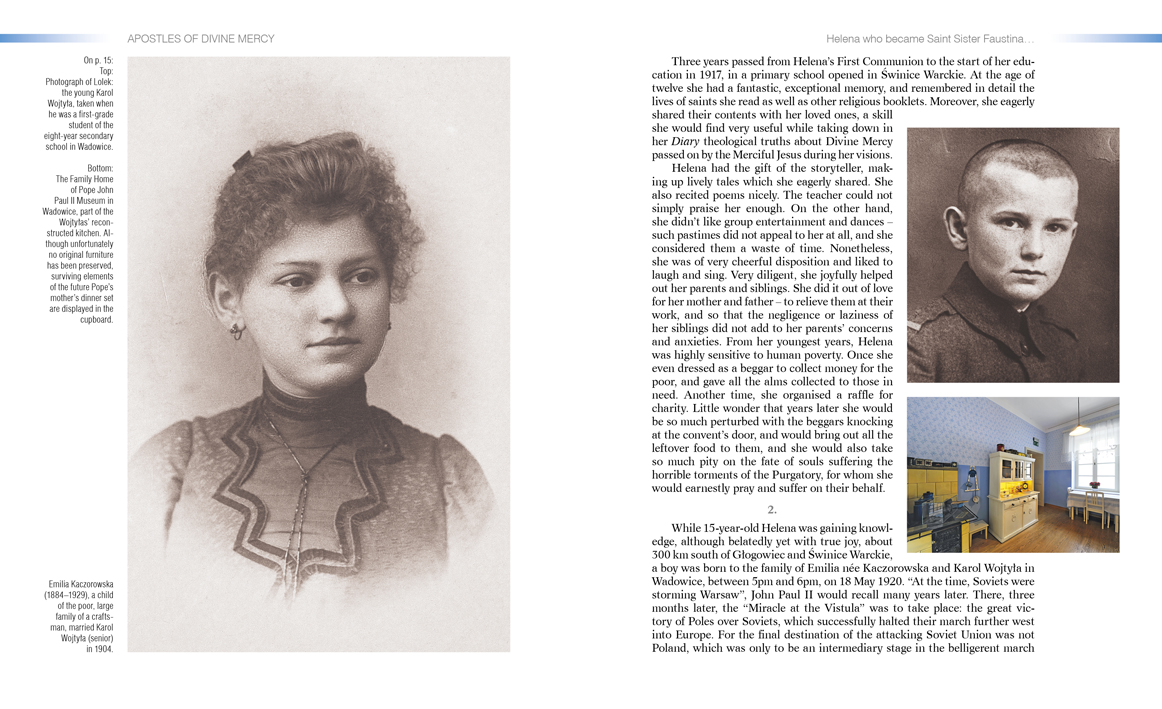



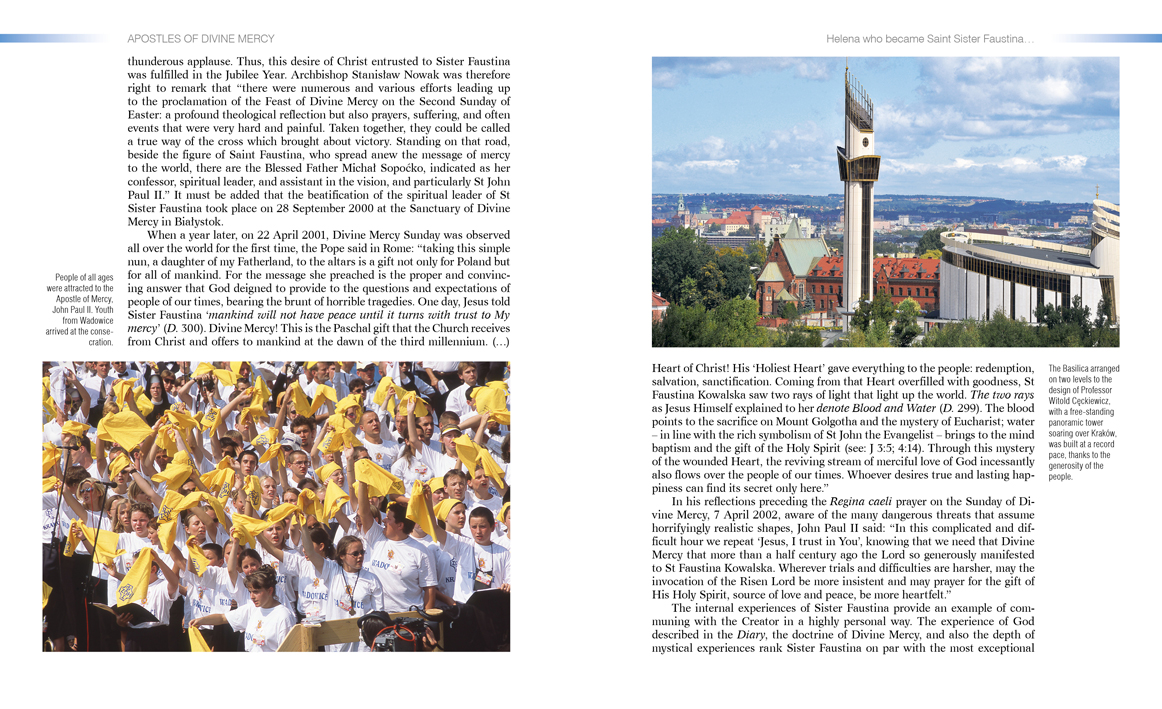
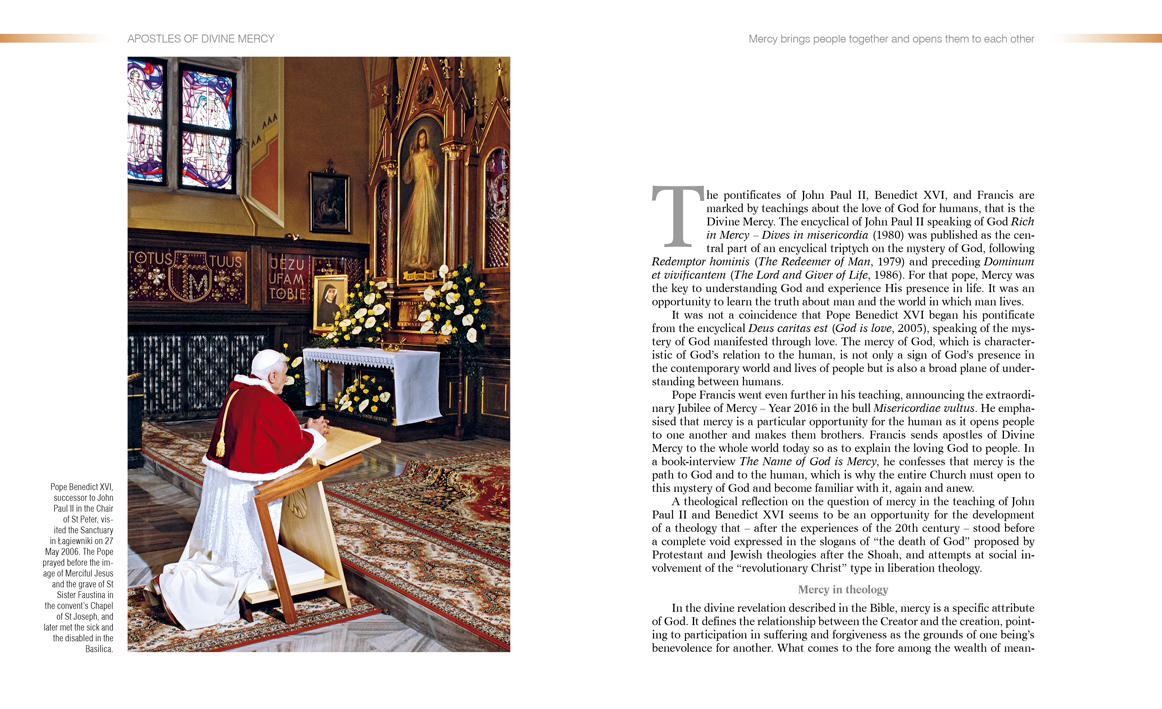
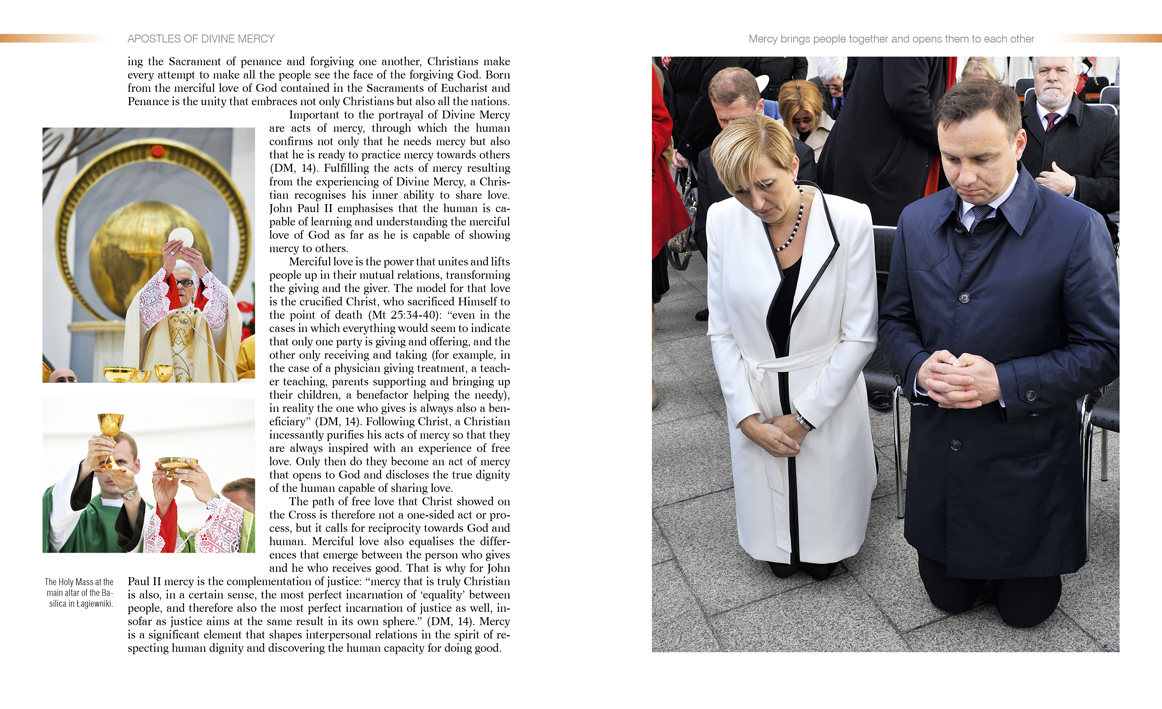
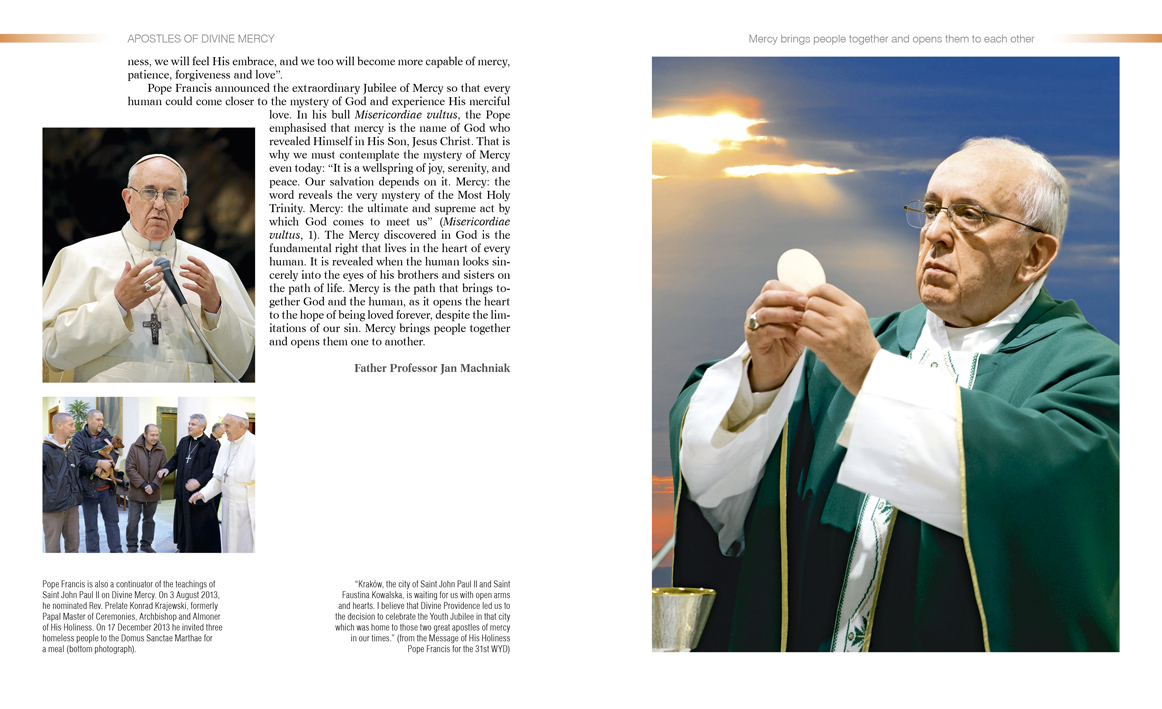
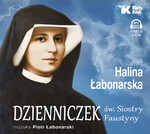
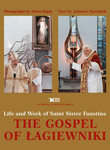
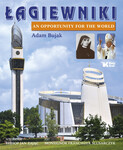

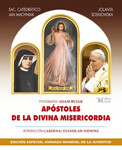



Krysztof
Apostołowie Bożego Miłosierdzia to św. Jan Paweł II oraz św. Faustyna. Nie wolno nam o tym zapominać, mamy dług wdzięczności wobec naszych polskich Apostołów.